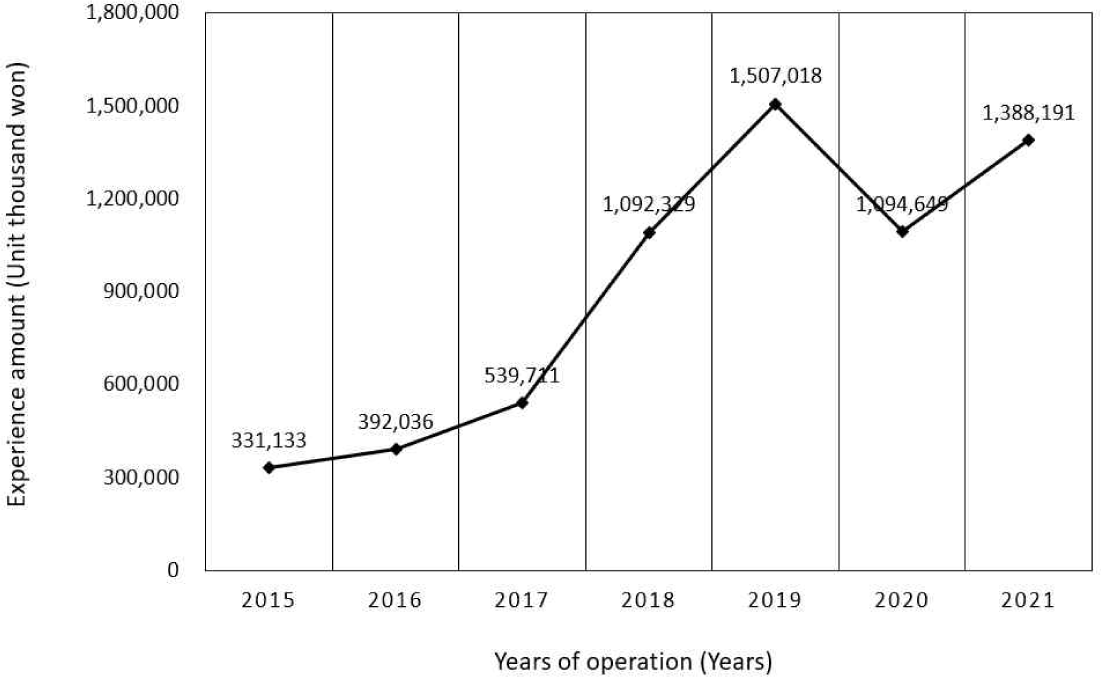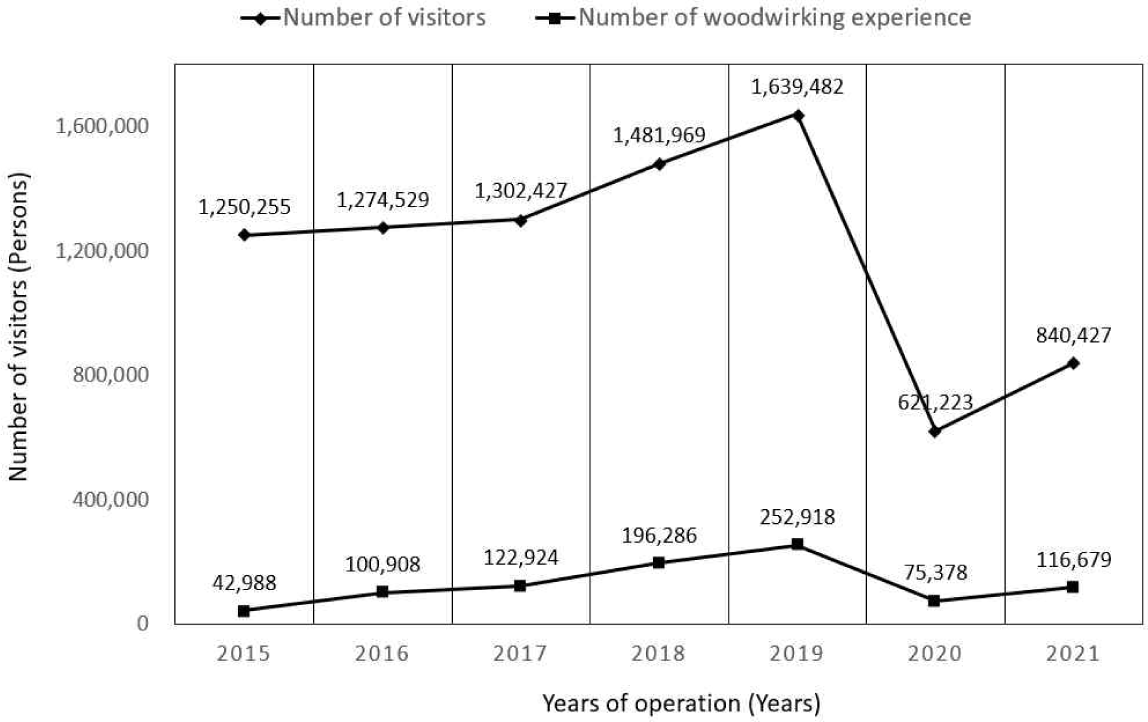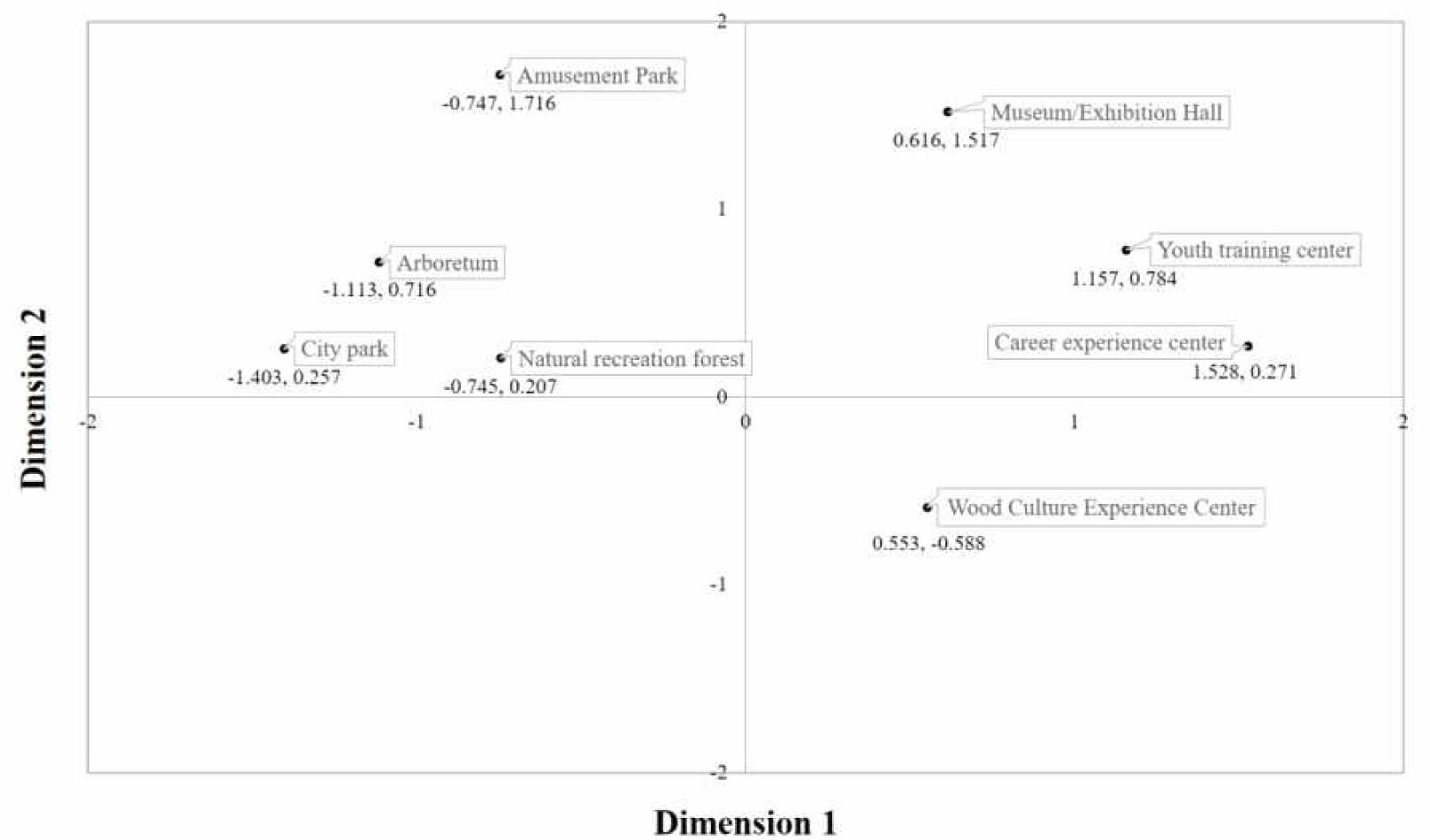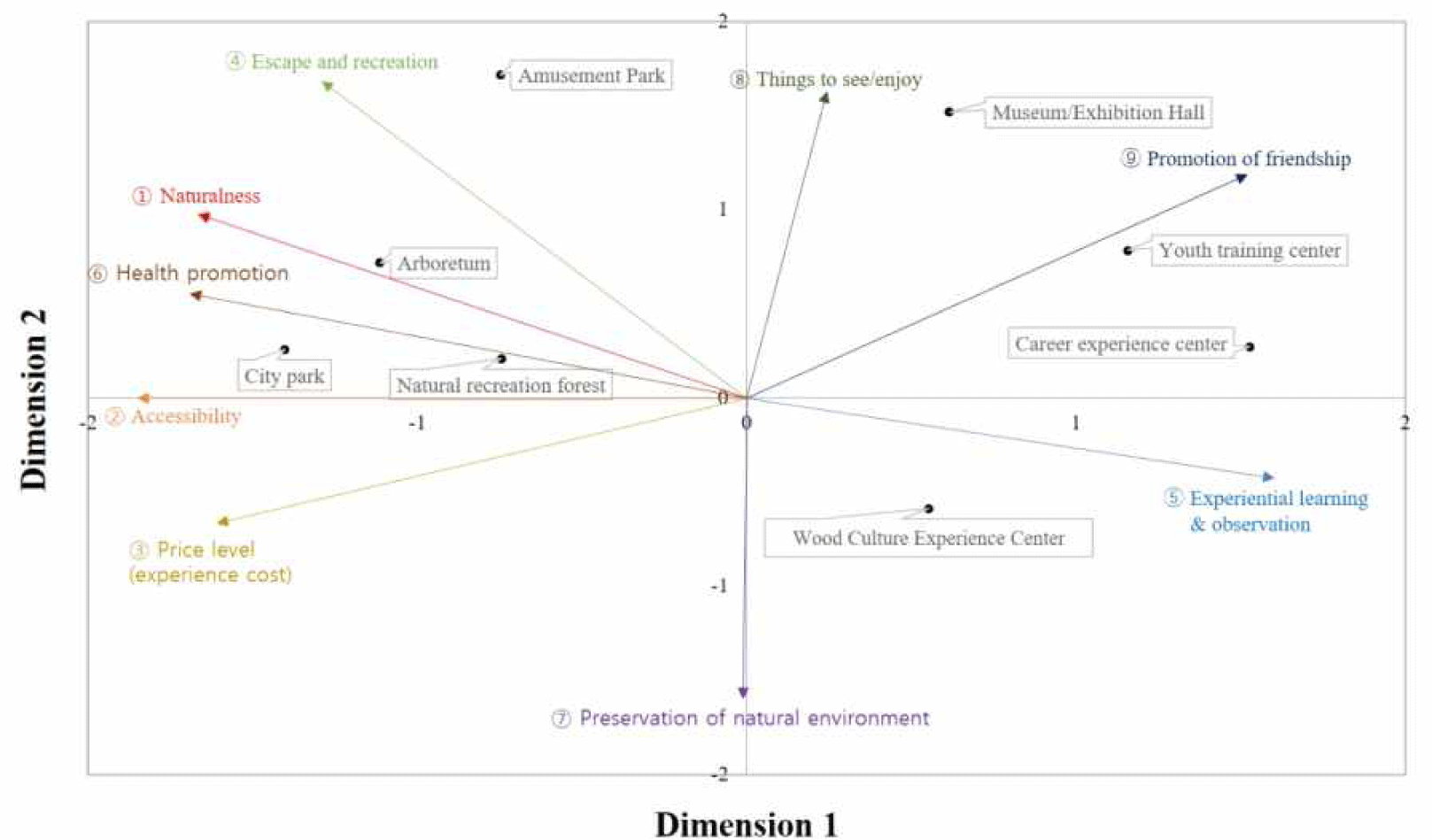1. INTRODUCTION
Global warming has brought unprecedented extreme weather events around the world in recent years, and climate change is accelerating beyond expectations (Korea Association of Wood Culture, 2019). If a global temperature increases by more than 2°C, it will cause natural disasters such as heat waves, cold waves, forest fires, typhoons, and floods, as well as various issues such as socio-economic losses, political conflicts, and disputes (Park et al., 2023). The higher uncertainty due to climate change has made it difficult to control these issues, and the international community has begun to strive to respond to them. As a result, carbon neutrality policies have emerged as a crucial countermeasure, and carbon neutrality has been widely accepted as the most useful method to address climate change (Liu et al., 2023). This concept means that carbon dioxide absorption increases as much as carbon dioxide emissions, which are generated by companies or individuals, reaching net zero emissions. In other words, by taking measures to absorb enough carbon dioxide to offset the amount of carbon dioxide emitted into the atmosphere, the total amount of carbon dioxide is neutralized (Lee, 2023).
Effective achievement of carbon neutrality requires more carbon sinks and carbon emission reduction; it is also necessary to encourage local residents to understand the meaning and necessity of carbon neutrality, and to participate in carbon neutrality-related activities through relevant education to improve and promote an awareness of carbon neutrality (Han et al., 2022; Jeon, 2010; Lee and Kim, 2023; Yang et al., 2023). As for wood, 48%–50% of its weight consists of carbon, and is an excellent material for achieving carbon neutrality. Therefore, the need for educational facilities has been emphasized for more education and higher awareness of the appropriate usage of wood and carbon neutrality (Cha et al., 2022; Choi et al., 2022; Han and Lee, 2021a; Ju et al., 2023; Lee et al., 2022; Ozdemir et al., 2023; Shrestha, 2022). The Wood Cultural Experience Centers were created as educational places specialized for meeting these needs, but currently, most of them are being used for exhibitions or for providing basic experiences without educational elements, and it is necessary to differentiate them from existing forest complexes and experience facilities in terms of leisure activities and educational functions.
Successful operation of the Wood Cultural Experience Center requires differentiation to create a unique position compared to other facilities, and consistency to maintain it over time. The center is a tourism and public destination that is closely related to eco-friendly facilities and carbon neutrality education and experience. It is essential to analyze and identify the competitiveness and preferences of similar leisure activities and experience facilities in South Korea. A perceptual map is created to identify consumer preference levels and the position of competitors in competition markets, and positioning refers to the localization on the map (Yoon and Lee, 2011). In marketing strategies, the process of making consumers aware of a particular product involves an evaluation and analysis of several factors such as product characteristics, relationships with competing products, and corporate images, and setting the product in a specific position in the competition (Choi et al., 2017).
This study analyzed the competitiveness of similar facilities to the Wood Cultural Experience Center in terms of leisure activities and educational functions, and derived a positioning for the differentiation and consistency of the center. The research was conducted in the following order. First, while targeting all the Wood Cultural Experience Centers in operation, it investigated the emergence and current operation status of the centers, and policy changes. Second, it performed a positioning analysis to scientifically examine how visitors consider the Wood Cultural Experience Centers, and what attributes differentiate the centers from other similar facilities. In this sense, this study examines the current operation of the Wood Cultural Experience Centers and suggests an efficient operation model.
2. MATERIALS and METHODS
The study aims to explore efficient operation strategies of the Wood Cultural Experience Centers after deriving the differentiation and consistency of the centers by targeting visitors of the Wood Cultural Experience Center and identifying the contributors to the visit and their preferences per facility. Most of the multidimensional scaling methods for positioning settings use two dimensions for comparative analysis to facilitate interpretation (Kang et al., 1999). This study selected similar facilities to the centers in terms of leisure activities and educational functions as the research targets. In order to identify the properties of the research targets, this study chose nine important properties that facilities have in common or different from each other based on the literature review: naturalness, accessibility, price level (experience cost), escape from daily life or recreation, experiential learning or observation, health promotion, preservation of the natural environment, things to see/things to enjoy, and friendship promotion, and the study was performed using the procedure shown in Fig. 1.

The questionnaire in this study consists of four parts as shown in Table 1. First, it consists of seven items regarding the research targets: gender, age, occupation, cognitive path, characteristics of visit, number of uses, and purpose of visit. Second, it consists of nine items of flow derived from the literature review to analyze the contributors to the visit. Third, it aims at evaluating the preferences of facilities based on satisfaction via an ordinal scale (range: 1st place–3rd place). Finally, for the similarity analysis between the Wood Cultural Experience Center and similar facilities in terms of leisure activities and educational functions (e.g., Wood Cultural Experience Center, career experience center, youth training center, natural recreation forest, museum/exhibition hall, arboretum, city park, and amusement park), eight facilities were in pairs of two, and the similarity was evaluated based on a Likert 5-point scale (1 = very similar, 2 = similar, 3 = neutral, 4 = dissimilar, 5 = very dissimilar).
The most basic principle of the multidimensional scaling method is to visually express the given data in a space with potential dimensions derived from the data, and to evaluate attributes of targets to be evaluated by using a matrix of similarity or dissimilarity and representing them based on the concept of distance in dimensional space. These attributes include preference and attribute evaluation data, and a vector model is employed to derive the direction and ideal point of the coordinates.
The sample of this study consists of those who are older than 20 years old, and are aware of the Wood Cultural Experience Centers; the survey method is convenience sampling; the survey (1,000 respondents) was conducted by personal interviews from April 1 to 30, 2022 at the Wood Cultural Experience Center in Jinju (Wolasan Woodland and Jinyangho Woodland) and the Wood Cultural Experience Center in Geoje. Specifically, researchers (nine persons interested) conducted the survey inside the Wood Cultural Experience Centers mainly through self-administered questionnaires and individual interviews.
The collected data were analyzed by the statistical analysis program SPSS (IBM Statistics 25, IBM, Armonk, NY, USA), and the statistical processing method was applied as follows. First, a frequency analysis was performed to analyze the demographic characteristics of the respondents. Second, reliability analysis and confirmatory factor analysis were performed to identify the internal reliability and validity of the variable, contributors to the visit. Third, descriptive statistical analysis was conducted to identify the normal distribution per facility. Fourth, the Kruskal, Young, Sheperd, Togerson (KYST) analysis was performed to identify similarities among facilities, and a regression analysis was also conducted to examine attribute perceptions of the Wood Cultural Experience Centers.
KYST is the most widely utilized method among multidimensional scaling methods, showing the properties of targets to be evaluated in a two-dimensional space based on proximities regarding similarity or dissimilarity scales among evaluation targets, and identifying monotonic relationships using stress values. This study utilized a non-metric statistical method by Alscal to derive conclusions, by comprehensively combining the preferences of multiple respondents and expressing them per property on the perceptual map after representing the vectors of consumer preferences on the targets, subjects, and products to be evaluated, and product attributes on the spatial coordinates (Kim and Yoon, 2010).
3. RESULTS and DISCUSSION
The Wood Cultural Experience Centers located in each region aim to satisfy the demand for wood culture experience in nearby areas, and to build nationwide linkages among centers to enable Korean citizens to easily experience wood culture. Furthermore, the centers promote the excellence of wood through wood culture experiences and learning activities, create potential demand for wood usage, improve the quality of life of the people through more rest areas with forest culture, and contribute to regional development by fostering wood as a specialized regional tourism resource. The centers provide a space for residents to use and experience various wood cultures, and serve as a complex venue with diverse functions such as education, exhibition, experience, and leisure for residents in order to expand the bases for wood utilization and wood culture. There should be a plan to use the centers as spaces with multipurpose so that wood can be utilized in diverse areas from experience centers to daily life (Park and Choi, 2021).
As of January 2023, there are 50 Wood Cultural Experience Centers in operation in South Korea, and 10 centers are in preparation for construction. As for the current status of centers in operation per year, there were six centers in 2012, seven centers in 2013, eight centers in 2014, 15 centers in 2015, 18 centers in 2016, 24 centers in 2017, 32 centers in 2018, 36 centers in 2019, 39 centers in 2020, 44 centers in 2021, and 49 centers in 2022 (Korea Association of Wood Culture, 2019).
Table 2 shows the current status of the Wood Cultural Experience Centers in the central parts of the country; 25 centers are in operation or preparation for operation: one center in Incheon and Daejeon, respectively, four centers in Gyeonggi Province, six centers in Gangwon Province, and six centers in Chungcheong Province. Table 3 indicates the current status of the Wood Cultural Experience Centers in the southern part of the country; 29 centers are in operation and 4 centers are in preparation for operation: two centers in Daegu Metropolitan City, 13 centers in Jeolla Province, and 18 centers in Gyeongsang Province. Table 4 presents the current status of Jeju Island; one center is in operation and one center is in preparation for operation; a total of two centers have been constructed.
| Province | City/county | Location | Operating |
|---|---|---|---|
| Jeju (2) | Seogwipo | 1487-73, Namjo-ro, Pyoseon-myeon, Seogwipo | ‘17/08 |
| Seogwipo | Gulmae Ecological Park, Chilsimni Park | Under construction |
Fig. 2 indicates the current status of the annual number of visitors and visitors with woodworking experience. It shows a gradual increase until 2019 in terms of the current status. In 2019, the total number of visitors to all 39 Wood Cultural Experience Centers was 8.41 million, and the total number of visitors with woodworking experience was 900,000. The number of experience centers increased by approximately 2.4 times from 15 in 2015 to 36 centers in 2019; the number of visitors increased by around 1.3 times from approximately 1.25 million in 2014 to about 1.64 million in 2019. Such an increase in visitors can be due to the higher number of Wood Cultural Experience Centers that have been constructed. The number of visitors with woodworking experience also showed an increasing trend until 2019, with a significant increase of approximately 5.9 times compared to the 2015 level. The ratio of the number of visitors participating in woodworking experience to all visitors gradually increased from 3.32% in 2015 to 7.34%, 8.60%, 11.70%, and 13.36% from 2016 to 2019 (Korea Association of Wood Culture, 2019).
On the other hand, from 2020 onwards, the numbers of visitors and visitors with woodworking experience decreased by 62.11% and 70.20% year-on-year due to COVID-19, but despite the prolonged COVID-19, the numbers increased by 35.29% and 54.79% year-on-year in 2021, indicating an overall recovery trend. These findings indicate higher recovery rates compared to the findings of Kwon and Park (2021), which analyzed the status of visitors to main tourist attractions after COVID-19, and showed an average recovery rate of visitors per facility (22.5%). Such a finding indicates that the type with less impact from COVID-19 is the “nature and ecological environment type” with a higher recovery rate than the previous year in 2020 (Choi and Kim, 2021).
Fig. 3 shows that the annual revenue from visitors with woodworking experience to the Wood Cultural Experience Centers tended to increase until 2019 in line with fluctuations in the number of visitors, and then after COVID-19 in 2020, there was a decreasing and increasing tendency. The annual revenue showed the same tendency as the annual number of visitors with woodworking experience.

The importance of wood usage has been emphasized due to responses to climate change, and the usage has been considered an important issue from a national perspective; Korea Forest Service enacted the Act on the Sustainable Use of Timbers for more active usage of wood. Every year, the Korea Forest Service measures and announces the wood culture index, which is an index that measures and quantifies policies for promoting wood utilization and wood culture, social infrastructure, and levels of using wood by people through legislation. The wood culture index has shown an annual increase from 2016 to 2019; recently, in 2022, the national average of the index was 62.0 points, an increase of 1.6 points from the previous year, but the index on perception of wood and wood culture was 43.9 points, which dropped by 0.7 points compared to the previous year, because social infrastructure and policies could not support the high interest of the general public in wood (Korea Association of Wood Culture, 2022). Such a tendency is assumed attributable to the fact that despite a relatively favorable social atmosphere for wood usage and woodworking activities, there are few opportunities to enjoy wood culture in reality, resulting in a lack of awareness and foundation for wood culture. Thus, it is necessary to discover various wood culture resources through a systematic classification of wood culture, and relevant case studies, prepare basic materials to establish promotion strategies enabling people to enjoy wood culture, and provide alternatives to form social consensus and facilitate wood culture. Han and Lee (2021b) conducted a survey on necessary measures to popularize wood cultural resources; the highest response rate was found in strengthening the promotion of wood culture (32.6%), followed by human resource training and infrastructure support (25.6%), development of related content (24.6%), and establishment of wood culture-related policies (16.8%). They also suggested the need to develop various content and promote the content to the public by establishing wood culture-related policies.
Table 5 shows the frequency analysis results based on the survey of 1,000 visitors for the positioning of the Wood Cultural Experience Centers.
As for gender, more females were surveyed with 363 males and 637 females, and as for age, respondents in their 20s, 30s, 40s, 50s, and 60s or older accounted for 15.6%, 44.1%, 25.6%, 12.0%, and 27.0%, respectively, showing that respondents in their 30s showed the highest rate. In terms of the occupation of the respondents, the highest percentage of respondents were found in daycare/kindergarten teachers 22.8%, followed by elementary school teachers, office/administrative workers, full-time housewives, technical/service workers, middle and high school teachers, self-employed, and others (e.g., students, etc.). As for the visit characteristics, there were 723 individuals and 277 groups. In terms of cognitive path, the following channels were highly used: blogs accounted for 30.1% and recommendations from others accounted for 26.7%. The highest number of visits was more than once a month at 37.5%, followed by more than once a year or more, first visit, and more than once a week. The main purpose of visiting the Wood Cultural Experience Centers was to experience wood and woodworking (38.7%), followed by amusement facilities (23.7%), explanation of forests (11.3%), exhibition viewing (9.8%), forest experience for infants (8.4%), movie watching (5.0%), forest walk (4.2%), and weekend special experience (3.4%).
Similarity analysis refers to identifying the position of each brand in consumers’ minds. This study created a perceptual map based on the relative positions of recreational activities and educational functions of eight facilities. In other words, respondents were asked to evaluate the pairwise comparisons of similarity for each of the n(n–1) / 2 pairwise comparisons (28) of the eight facilities based on a 5-point Likert scale (1 = very similar, 2 = similar, 3 = neutral, 4 = dissimilar, 5 = very dissimilar), and Table 6 showed the KYST analysis results.
In the empirical study on the image positioning of the Wood Cultural Experience Centers, a total of 1,000 visitors to the centers were surveyed about the image positioning of each forest resort, and based on the collected data, the image attribute space map was created through the KYST analysis, as shown in Fig. 4. When facilities with high similarity are generally located close to each other on the positioning map, it indicates that their relationships are highly competitive, whereas brands that are relatively far away from each other show dissimilarity, which can be interpreted that their relationships are not highly competitive. In this sense, as shown in Figs. 4 and 5, the Wood Cultural Experience Center has strong competition with the natural recreation forest in terms of naturalness; in terms of experiential observation, it also has strong competition with the career experience center and youth training center, but it has a weak competition with other similar facilities because those facilities are relatively far away.
In the overall preference survey that evaluated the preferences of facilities based on satisfaction via ordinal scale (range: 1st place–3rd place), the Wood Cultural Experience Center was the highest with 714 respondents (23.80%), followed by natural recreation forest (20.27%), arboretum (15.73%), museum/exhibition hall (10.67%), Career experience center (8.00%), youth training center (7.60%), city park (7.47%), and amusement park (6.47%).
Based on the results of the attribute space map shown in Fig. 5, the overall positioning analysis results per target were derived, as shown in Table 7. The Wood Cultural Experience Centers were positively perceived in terms of such attributes as naturalness, experiential learnings or recreation, and preservation of the natural environment, whereas they were negatively recognized in terms of accessibility, escape from daily life, and things to see. In particular, the Centers were perceived very positively in terms of the attribute of experiential observation, which can be interpreted as the result of high investment in facilities and operations to meet the higher demand for group experiences such as experiential learning, creative learning, and excursions. From this perspective, it is necessary to develop programs that can provide diverse experience opportunities for the differentiation and consistency of the Wood Cultural Experience Centers. As for the recent trends from the perspective of ensuring the safety of visitors, various types of experiences should be developed and secured, such as one-person furniture making, wood carving, camping equipment making, and pet product making. Such activities can also contribute to securing profit sources for the sustainable management of the Wood Cultural Experience Centers from a business perspective.
Next, it is necessary to actively employ the Wood Cultural Experience Center’s comparative advantages from naturalness and preservation of the natural environment, that is, its outstanding scenery and excellent carbon neutrality education compared to other similar facilities. In other words, centers can be positioned as the most spectacular destinations while enjoying the best forests, and simultaneously, the location for education and experience on carbon neutrality. They also need to be positioned as the best place to experience nature as much as possible, and simultaneously, preserve the natural environment.
Finally, resetting should be considered to compensate for negative attributes of accessibility, escape from daily life or recreation, and things to see/enjoy. It is also important to develop a program for connecting surrounding facilities via local infrastructure, to review constructing spaces and facilities for various things to see and play facilities, and to manage vacationers and those who particularly want to commune with nature.
4. CONCLUSIONS
This study was conducted to examine the current status of the Wood Cultural Experience Centers and to suggest a successful operation model through positioning analysis of similar facilities with leisure activities and educational functions, and the following results were derived.
First, there are 49 Wood Cultural Experience Centers in operation (as of 2022). The number of visitors and visitors with woodworking experience has continuously increased, and there is an overall trend of recovery after the decline due to the onset of the COVID-19. The annual revenue from visitors with woodworking experience showed the same trend as the annual number of visitors with woodworking experience. Second, as a result of the similarity analysis (KYST) of facilities with recreational activities and educational functions, centers have competition with natural recreation forests in terms of naturalness, and they have competition with career experience centers and youth training centers in terms of experiential observation. Third, the result of analyzing positioning via an attribute space map indicates that the Wood Cultural Experience Centers were positively recognized in terms of such attributes as naturalness, experiential learning or recreation, and preservation of the natural environment, whereas they were negatively perceived in terms of accessibility, escape from daily life, and things to see. Fourth, the entire preference survey showed that the Wood Cultural Experience Center was the most preferred, followed by the natural recreation forest, arboretum, museum/exhibition hall, career experience center, youth training center, city park, and amusement park. Therefore, it is necessary to develop and secure various types of experiences for the successful operation of the Wood Cultural Experience Centers, actively utilize outstanding scenery and excellent carbon neutrality education, and review constructing spaces and facilities for various things to see and play facilities. It is also important to develop and operate a systematic program to manage the program for a long time at the Wood Cultural Experience Centers. The entire program should be divided into three programs for weekdays, weekends, and play experience, so that it can be effectively operated without gaps.



